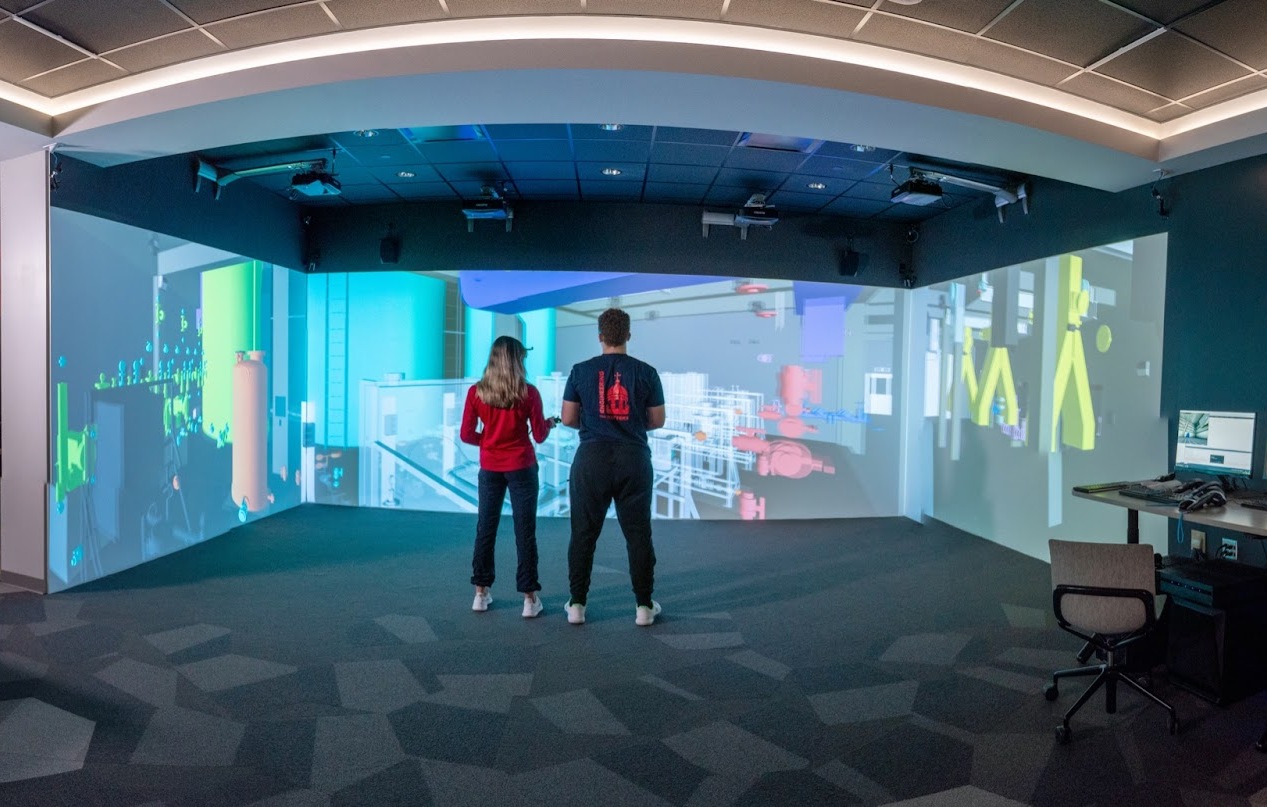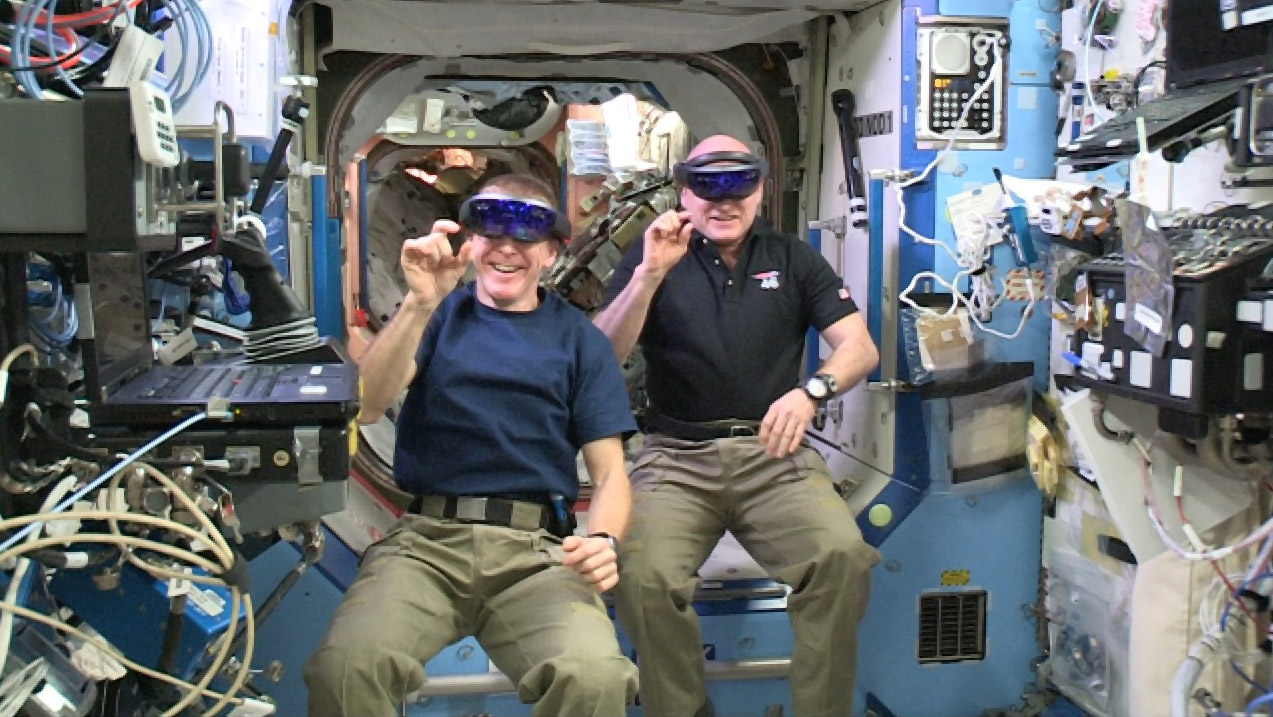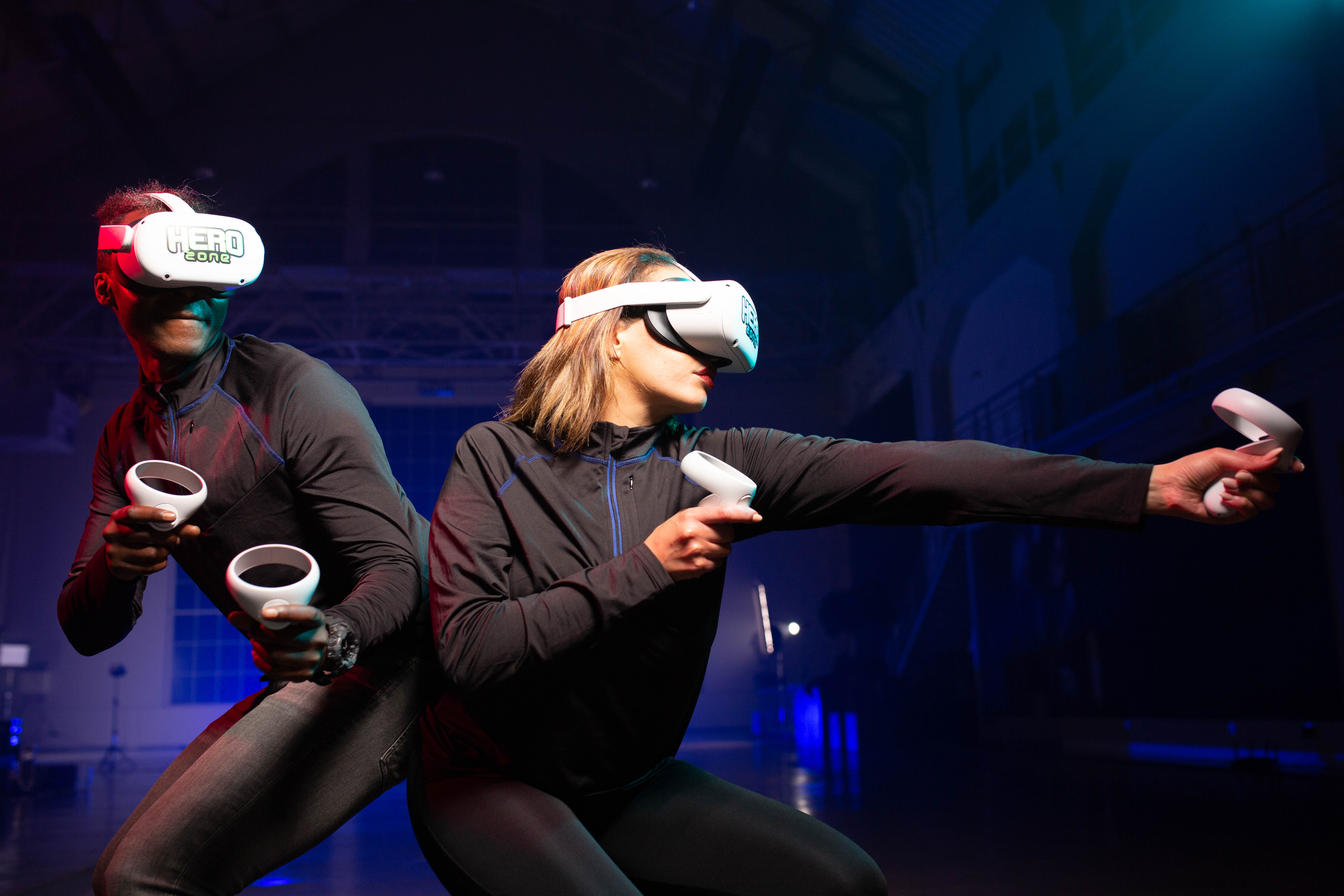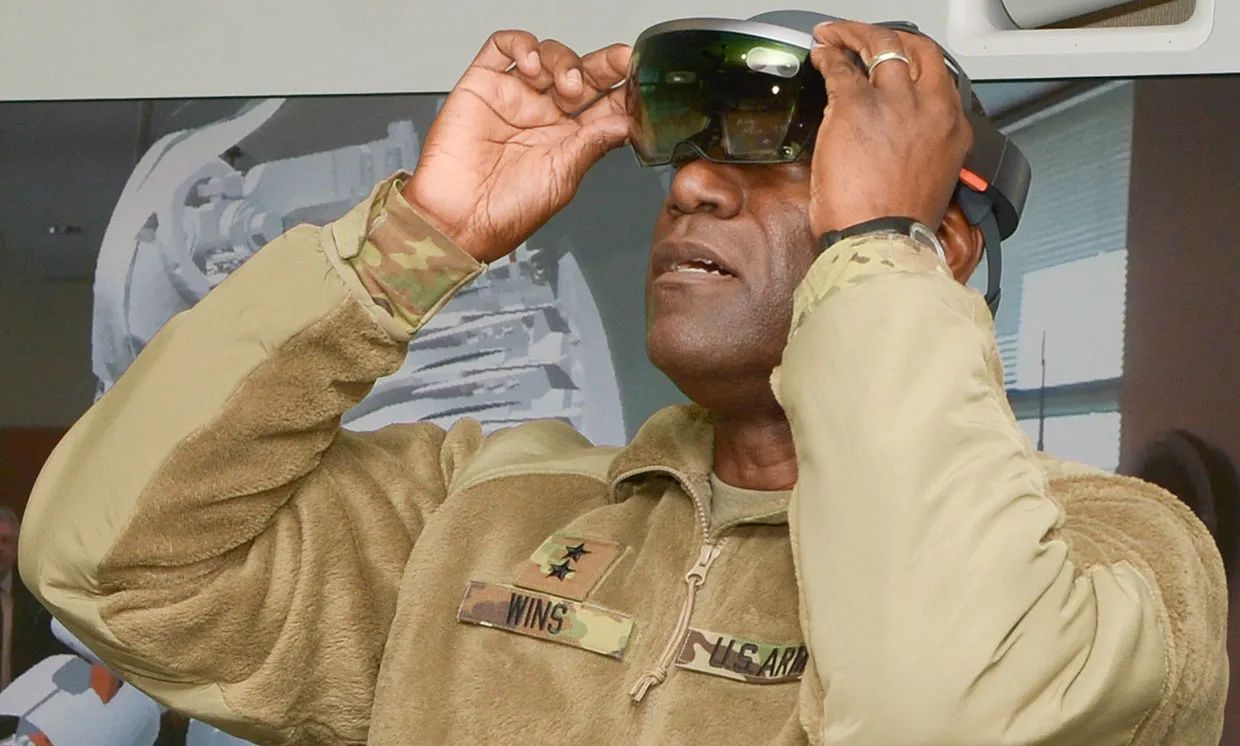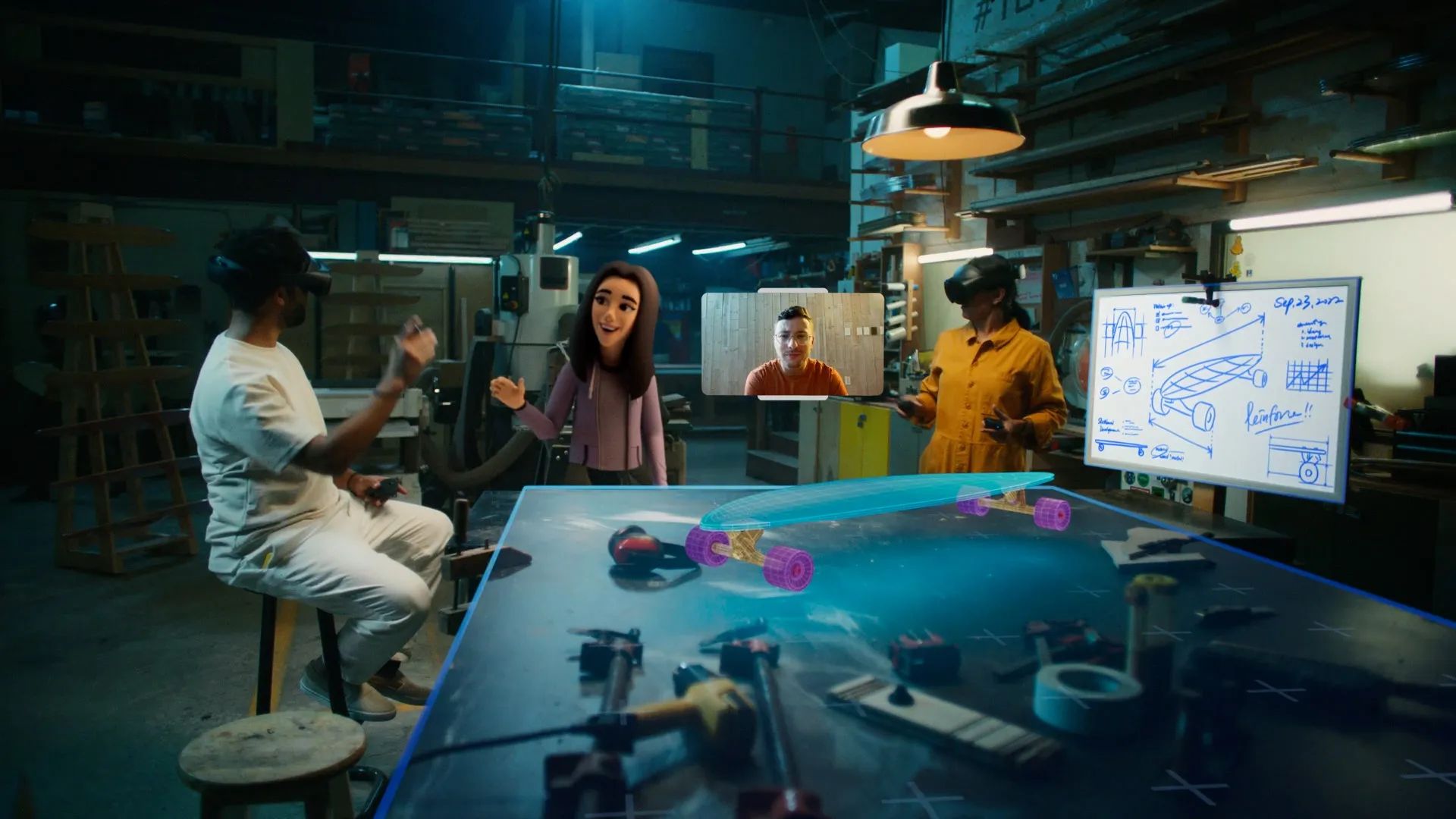Introduction
Welcome to the fascinating world of virtual reality (VR), where you can immerse yourself in breathtaking and realistic experiences without even leaving the comfort of your own home. Virtual reality has revolutionized the way we interact with digital content, offering a truly transformative and captivating experience.
In this article, we will explore the concept of virtual reality and guide you through the process of creating your very own virtual reality room. Whether you are a tech enthusiast, a gaming aficionado, or simply curious about this innovative technology, creating a virtual reality room will enable you to fully embrace the world of VR and take your entertainment to a whole new level.
Virtual reality has experienced significant growth in recent years, with advancements in technology making it more accessible and affordable for consumers. The ability to be fully immersed in a virtual environment, where you can explore new worlds, engage in interactive games, and even learn new skills, has captured the interest and imagination of people worldwide.
By setting up a dedicated virtual reality room in your home, you can create an optimal environment for your virtual reality experiences. This room will provide the necessary space and equipment to fully immerse yourself in the digital world, and will be a place where you can escape reality and embark on incredible adventures.
Whether you are a casual user or a serious enthusiast, having a designated space for virtual reality will enhance your overall experience and make it more convenient and enjoyable. In the following sections, we will take you step-by-step through the process of creating your own virtual reality room, from choosing the right space to customizing the environment to suit your preferences.
So, are you ready to step into the extraordinary realm of virtual reality? Let’s get started on the journey to creating your very own virtual reality room!
What is Virtual Reality?
Virtual reality (VR) is an advanced technology that simulates a realistic environment and enables users to interact with it in a highly immersive way. By wearing a VR headset and using motion-tracking devices, users are transported into a three-dimensional virtual world that can be explored and manipulated.
VR technology has come a long way since its inception, with significant advancements in both hardware and software. The VR headset, also known as a head-mounted display (HMD), is a crucial component of the VR experience. It typically consists of a high-resolution display screen, built-in sensors, and head-tracking capabilities.
When wearing a VR headset, users are completely immersed in a digital environment that may range from video games and simulations to educational and training programs. The headset tracks the user’s head movements, allowing them to look around and explore the virtual world as if they were truly present.
Aside from the visual aspect, virtual reality also incorporates other sensory elements to enhance the overall experience. This may include spatial audio, haptic feedback, and even scent simulations, creating a multi-sensory illusion that closely replicates real-world environments.
Virtual reality has a wide range of applications beyond gaming and entertainment. It is increasingly being used in various industries such as healthcare, architecture, education, and engineering. VR allows professionals to visualize, analyze, and manipulate complex data in a more intuitive and interactive manner.
One of the key benefits of virtual reality is its ability to transport users to places or situations that would otherwise be difficult or impossible to explore in the physical world. From exploring the depths of the ocean to walking through historical landmarks, VR enables users to have unique and immersive experiences without leaving their physical location.
The potential of virtual reality is immense and continues to expand as technology advances. As more developers and content creators embrace VR, we can expect to see a vast array of virtual reality experiences that cater to different interests and preferences.
In the next section, we will delve into the benefits of creating a virtual reality room and how it can enhance your overall VR experience.
Benefits of Creating a Virtual Reality Room
Creating a dedicated virtual reality room in your home offers several benefits that enhance your overall VR experience. Let’s explore some of the key advantages:
- Optimal Space: Having a dedicated room for virtual reality allows you to have sufficient space for movement and interaction. Whether you are exploring virtual worlds, engaging in active games, or practicing virtual training exercises, having enough room to move freely enhances the immersion and prevents any physical obstructions.
- Reduced Distractions: By creating a designated virtual reality space, you can minimize distractions and interruptions from the outside world. Ensuring a quiet environment free from external noises and disturbances allows you to fully focus on your virtual reality experiences, making them more immersive and enjoyable.
- Protection and Safety: Virtual reality systems typically involve motion-tracking sensors or cameras that require a clear and unobstructed view. By designating a specific room for VR, you can ensure that the sensors are properly calibrated and the tracking is accurate, minimizing the risk of accidents or collisions with objects in the room.
- Enhanced Immersion: Creating a virtual reality room allows you to optimize the lighting, sound, and other environmental factors to enhance the overall immersion. Controlling the lighting conditions to match the virtual environment and using high-quality surround sound systems can further transport you into the digital world, making the experience more realistic and engaging.
- Customization and Personalization: Having a dedicated VR room gives you the freedom to customize the environment to suit your preferences. You can decorate the room with VR-themed artwork, use dedicated shelving for VR equipment storage, and even incorporate themed furniture to enhance the overall ambiance and create a space that truly reflects your love for virtual reality.
- Sharing Experiences: With a dedicated VR room, you have the perfect space to showcase virtual reality to your friends, family, or guests. Whether you want to introduce someone to VR for the first time or engage in multiplayer VR experiences, having a room designated for VR makes it easier and more convenient to share the excitement and wonders of virtual reality with others.
By creating a virtual reality room, you not only optimize your overall VR experience but also ensure a dedicated and immersive space where you can fully embrace the wonders of virtual reality. In the next section, we will provide a step-by-step guide to help you create your own virtual reality room.
Step-by-Step Guide to Creating a Virtual Reality Room
Creating a virtual reality room requires careful planning and setup to ensure an optimal VR experience. Let’s explore the step-by-step process to help you create your own VR room:
- Choose the Right Space: Select a room that provides enough space for movement without any obstructions. Consider factors such as the size of the room, accessibility to power outlets, and the ability to control lighting conditions.
- Install VR Equipment: Set up your VR headset, motion controllers, and any other VR peripherals according to the manufacturer’s instructions. Make sure to place the VR computer or console in a location accessible to the VR room and connect any necessary cables.
- Set Up Sensors and Tracking Devices: Position the sensors or cameras in the room according to the recommended guidelines provided by the VR system. Ensure that you have a clear line of sight and optimal coverage for accurate tracking of your movements.
- Optimize Lighting and Sound: Adjust the lighting in the room to match the virtual environment. Consider using ambient lighting or dimmers to create a more immersive experience. Install a surround sound system or high-quality headphones to enhance the audio immersion.
- Create a VR-Friendly Environment: Clear the room from any potential hazards or obstructions that may interfere with your VR experience. Secure loose cables and keep the area clean to prevent accidents. Consider using a rug or marked area to indicate the boundaries of the play area.
- Customize the Room’s Virtual Reality Experience: Personalize the VR room by adding VR-themed decor, artwork, or dedicated shelving for your VR equipment. Consider adding comfortable seating options or bean bags for VR spectators or when taking breaks.
Following these steps will help you set up a dedicated virtual reality room that enhances your overall VR experience. It provides a dedicated space where you can comfortably explore the digital world and fully immerse yourself in breathtaking virtual reality experiences.
In addition, don’t forget to regularly maintain and update your VR equipment, ensure proper ventilation in the room, and always follow the manufacturer’s guidelines for safe usage.
Choose the Right Space
Choosing the right space for your virtual reality room is a crucial first step in creating an optimal VR experience. Here are some factors to consider when selecting the perfect room:
- Size: Ensure that the room you choose is large enough to accommodate your VR activities. You should have adequate space to move around freely without any physical obstructions. A larger room will allow for a more immersive experience, especially for games or simulations that involve active movements.
- Accessibility: Consider the accessibility of power outlets in the room. VR headsets and other equipment often require a power source, so make sure the outlets are conveniently located to avoid any tripping hazards from cables stretching across the room.
- Lighting Control: Ideally, you want to have control over the lighting conditions in your virtual reality room. Natural lighting can interfere with the display on your VR headset, causing glare or washed-out visuals. Consider using curtains or blinds that block out sunlight and provide you with better control over the room’s lighting.
- Privacy: If you prefer to immerse yourself completely in the virtual world without distractions or prying eyes, choose a room where you can have a higher level of privacy. This will allow you to fully engage with the VR experience without feeling self-conscious or interrupted.
- Furniture and Obstacles: Clear the room of any furniture or objects that may obstruct your movements or pose a safety risk. VR activities often involve standing, crouching, or even lying down, so removing any potential obstacles will ensure a safer and more enjoyable experience.
- Ventilation: Virtual reality can be an intense and physically engaging experience, causing you to work up a sweat. Ensure that the room has proper ventilation to keep you cool and comfortable during extended VR sessions. Consider using fans or opening windows to improve airflow in the space.
Remember, the goal is to create a dedicated virtual reality space that allows you to fully immerse yourself in the virtual world. By carefully selecting a room that meets these considerations, you can create an optimal environment for your virtual reality experiences.
Once you have chosen the right space, you can proceed with installing the necessary VR equipment and setting up the room to further enhance your virtual reality adventures.
Install VR Equipment
Installing the VR equipment is a crucial step in creating your virtual reality room. Here’s a breakdown of the necessary equipment you’ll need and how to properly install it:
- VR Headset: The VR headset, also known as a head-mounted display (HMD), is the key component that will transport you into the virtual world. Follow the manufacturer’s instructions to connect the headset to your computer or console using the provided cables. Make sure the headset is adjusted to fit comfortably on your head and provides a clear view of the display.
- Motion Controllers: Depending on your VR system, you may have handheld motion controllers that allow you to interact with the virtual environment. These controllers enable you to grab objects, point, and perform actions within the VR world. Pair the controllers with your VR headset according to the manufacturer’s instructions and ensure they are fully charged or have fresh batteries.
- Sensors/Cameras: Most VR systems require external sensors or cameras to track your movements in the real world. These sensors help to precisely track the position and orientation of your VR headset and motion controllers. Set up the sensors or cameras according to the manufacturer’s guidelines, usually by mounting them at specific locations in the room. Ensure there is a clear line of sight between the sensors and your equipment.
- Audio Setup: Great audio is an integral part of the immersive VR experience. Depending on your preference, you can use built-in headphones on the VR headset or connect external headphones for better sound quality. Make sure the audio output is properly configured to provide surround sound or spatial audio, enhancing the realism of the virtual environment.
- Power and Connectivity: Ensure that all the VR equipment is connected to the appropriate power sources. Make sure the cables are securely plugged in and not tangled or obstructing your movement. Double-check that all connections between the VR headset, motion controllers, and any external devices (such as cameras or sensors) are properly established.
It’s essential to follow the manufacturer’s instructions for your specific VR equipment to ensure proper installation and compatibility. Additionally, regularly updating the firmware and software of your VR system will ensure you have the latest features and improvements.
By properly installing the VR equipment in your virtual reality room, you’ll be ready to step into immersive virtual worlds and enjoy the countless experiences that await you.
Set Up Sensors and Tracking Devices
Setting up the sensors and tracking devices is a critical step to ensure accurate and seamless tracking of your movements in the virtual reality (VR) world. Follow these steps to properly set up the sensors and tracking devices in your VR room:
- Review Manufacturer Guidelines: Read the manufacturer’s instructions and guidelines specific to your VR system. Familiarize yourself with the recommended sensor placement and any specific requirements for optimal tracking performance.
- Positioning the Sensors: Depending on your VR system, the sensors may need to be positioned at specific locations in the room. Typically, a minimum of two sensors is required, with one placed in front and the other behind you. Additional sensors may be necessary for roomscale or more extensive tracking setups. Ensure that the sensors have a clear line of sight to the VR headset and motion controllers.
- Mounting Options: The sensors can often be mounted on walls, tripods, or dedicated stands. Use the recommended mounting option for your specific VR system to ensure stability and accurate tracking. Make sure to position the sensors at an appropriate height to capture your movements effectively.
- Calibration: Once the sensors are correctly positioned, follow the calibration process provided by the VR system. This may involve standing in specific positions or performing predefined movements to allow the tracking system to calibrate and recognize the room’s layout and dimensions. Calibration helps optimize tracking accuracy and reduces any perceived latency or lag.
- Testing and Adjusting: After installation and calibration, test the tracking by moving around the room with the VR headset and motion controllers. Ensure that the system accurately tracks your movements and that there are no blind spots or areas where tracking is inconsistent. If needed, make slight adjustments to the sensor positioning or angle to improve tracking reliability.
Remember, the goal is to establish a robust tracking system that accurately detects and translates your movements into the virtual environment. Taking the time to set up the sensors and tracking devices properly will greatly enhance your overall VR experience and immersion.
If you encounter any issues during the setup process or experience tracking problems, consult the manufacturer’s troubleshooting resources or contact their support for further assistance.
Once the sensors and tracking devices are properly set up, you can proceed to optimize the lighting and sound in your VR room to further enhance your virtual reality adventures.
Optimize Lighting and Sound
Optimizing the lighting and sound in your virtual reality (VR) room is essential for creating an immersive and realistic VR experience. Here’s how you can enhance the lighting and sound to fully immerse yourself in the virtual world:
- Lighting: Consider the lighting conditions in your VR room. Ideally, you want to minimize harsh or direct lighting that can cause glare on the VR headset’s lenses. Natural light from windows can interfere with the display, so use curtains or blinds to control the amount of light entering the room. Experiment with different lighting setups, such as dimmed lighting or colored LED lights, to create a more atmospheric and immersive environment.
- Sound: Sound plays a crucial role in the overall VR experience. Invest in a high-quality audio setup, such as a surround sound system or headphones, to fully immerse yourself in the virtual world. Position the speakers strategically to create a surround sound effect, enhancing the spatial audio within the VR environment. Adjust the volume levels to achieve the right balance between the VR audio and the ambient sound in the room.
- Ambient noise: Minimize any distracting ambient noises in your VR room. Ensure that the space is quiet, and external sounds are isolated as much as possible. Close windows to block out street noise, and consider using soundproofing measures, such as acoustic panels or sound-absorbing materials, to reduce echo and reverberation within the room.
- Audio cues: Pay attention to the audio cues within the VR experiences. These cues guide you through the virtual environment and provide valuable information about your surroundings. Ensure that the audio is clear and distinct, allowing you to fully engage with the virtual environment and react to auditory cues effectively.
- Atmospheric enhancements: Consider adding additional elements to further enhance the ambiance. For example, you could use scented candles or aroma diffusers to add a hint of fragrance that aligns with the virtual environment. This can enhance the sensory experience and make it feel more immersive.
Experiment with different lighting and sound setups to find the configuration that best suits your preferences and the specific VR experiences you enjoy. Optimize the lighting and audio based on the theme or mood of the virtual environments you are exploring.
Remember to strike a balance in your lighting and sound optimizations. You want to create a realistic and immersive experience without compromising your safety or creating discomfort. Regularly evaluate and adjust the lighting and sound settings as you explore different VR content to ensure the best possible experience.
Now that you have optimized the lighting and sound in your VR room, the next step is creating a VR-friendly environment by clearing the room of potential hazards and obstructions.
Create a VR-Friendly Environment
Creating a VR-friendly environment is crucial to ensure a safe and immersive virtual reality (VR) experience. Follow these steps to make your VR room comfortable and free from potential hazards:
- Clear the Space: Remove any furniture, objects, or obstacles that could impede your movements or pose a safety risk while wearing the VR headset. Ensure there is ample space for you to move around freely without any obstructions.
- Secure Loose Cables: Check for any loose cables and secure them to walls or floors using cable management solutions. This helps prevent tripping hazards and keeps the VR room organized.
- Cover or Protect Fragile Items: If there are any fragile items in the room, consider covering or relocating them to prevent accidental damage during active VR sessions. Ensure that valuables or delicate objects are safely out of reach.
- Mark Play Areas: Designating a play area within the VR room can help you stay within safe boundaries. Use tape or mats to mark the boundaries of the play area, ensuring that you have enough space to move but remain aware of the limitations.
- Protective Flooring: Consider using a soft, padded mat or carpeting to provide a more comfortable surface to stand on during extended VR sessions. This can help reduce strain on your feet and offer additional cushioning in case of accidental falls.
- Clean and Declutter: Keep the VR room clean and free from clutter to minimize distractions and ensure a clear play space. Regularly dust and vacuum to maintain a comfortable and sanitary environment.
- Safety Precautions: Familiarize yourself with any specific safety guidelines or recommendations provided by the VR system manufacturer. Follow best practices for using the equipment and take breaks when needed to prevent discomfort or fatigue.
Creating a VR-friendly environment will not only improve your safety but also enhance your overall immersion and enjoyment in the virtual world. By taking these steps, you can fully immerse yourself in the VR experience without worrying about accidents or interruptions.
Now that your VR room is ready, the next step is to customize the virtual reality experience to your preferences and explore the vast array of extraordinary virtual worlds.
Customize the Room’s Virtual Reality Experience
Customizing the virtual reality (VR) experience in your room allows you to personalize the ambiance, aesthetics, and overall feel of your VR adventures. Here are some ways to customize your VR room:
- Decor and Artwork: Add VR-themed decor, posters, or artwork to the walls of your VR room. Choose images that resonate with your favorite VR games, movies, or experiences. This not only adds visual appeal but also helps to create a dedicated space that reflects your passion for virtual reality.
- Dedicated VR Equipment Storage: Designate an area in your room for storing your VR equipment. This can be a shelf, cabinet, or charging station specifically designed to keep your VR headset, motion controllers, and other accessories organized and easily accessible.
- Themed Furniture: Consider incorporating themed furniture or seating options that complement the VR experience. For example, gaming chairs, bean bags, or LED lighting can create a more immersive atmosphere and enhance your comfort during extended VR sessions.
- Ambient Lighting: Install mood lighting or LED strips that can be customized to reflect different colors or patterns. Experiment with lighting schemes that coincide with the virtual environment you are exploring, further enhancing the immersive experience.
- Curtains or Room Dividers: Use curtains or room dividers to create a dedicated area within the VR room. This can help separate your VR space from the rest of the room, enhancing the sense of immersion and reducing distractions from the outside environment.
- Comfort Enhancements: Ensure the room is comfortable for extended VR sessions. Consider adding floor mats or cushions for more comfortable standing or seating options. If necessary, use a fan or adjust the room temperature to prevent overheating while you explore virtual worlds.
- Personalize VR Avatars or Avatars: In certain VR experiences or social applications, you may have the option to personalize your VR avatar or avatar representation. Take advantage of these customization options to create a virtual representation of yourself that truly reflects your personality and style.
By customizing your VR room, you not only enhance the visual and sensory aspects of the virtual reality experience but also create a space that resonates with your interests and preferences. Personalizing the VR room further immerses you in the digital world and brings a sense of ownership and excitement to your VR adventures.
Experiment with different customizations and adjust them based on the specific VR experiences you engage with. Find the right balance that enhances your immersion while maintaining a comfortable and enjoyable VR environment.
With your virtual reality room customized to your liking, you’re ready to embark on incredible virtual adventures and explore the vast possibilities that await you!
Additional Tips for Enhancing Your Virtual Reality Room
While you have already set up your VR room and customized it to suit your preferences, there are a few additional tips that can further enhance your virtual reality (VR) experiences. Consider the following suggestions:
- Keep the Room Clean: Regularly clean your VR equipment, including the headset, controllers, and sensors, to maintain optimal functionality. Dust and debris can affect tracking accuracy and display clarity, so ensure everything is free from dirt and smudges.
- Experiment with Room Perfumes: As an added touch, consider incorporating room perfumes or diffusers that align with the virtual environments you are exploring. Fragrances can contribute to the overall immersion by activating the sense of smell and enhancing the realism of certain VR experiences.
- Wearable Comfort: Opt for comfortable clothing that allows for unrestricted movement during VR sessions. Consider wearing breathable fabrics and avoiding jewelry or accessories that may interfere with the VR equipment.
- Engage in Regular Calibration: Depending on your VR system, periodic calibration of the sensors or cameras may be required to ensure accurate tracking. Check for software updates and follow the recommended calibration procedures provided by the manufacturer to maintain optimal performance.
- Ventilation and Air Circulation: VR sessions can generate body heat, so ensure proper air circulation and ventilation in the room to keep it cool and comfortable. This will help prevent overheating and discomfort during extended playtimes.
- Consider Room Acoustics: Experiment with room acoustics by adding sound-absorbing panels or curtains to reduce echo or reverb, enhancing the audio experience within the VR environment. This can create a more immersive soundscape and minimize outside noise distractions.
- Stay Hydrated: Remember to hydrate yourself adequately during VR sessions, as they can be physically engaging. Keep a water bottle nearby to ensure you remain refreshed and comfortable throughout your virtual adventures.
- Alternate Experiences: Explore a variety of VR experiences to fully take advantage of your dedicated VR room. Try different genres of games, educational experiences, or artistic VR applications to diversify your VR encounters and keep the excitement alive.
By incorporating these additional tips, you can enhance the overall VR experience within your dedicated VR room. Remember to stay informed about the latest developments in VR technology and software updates to take full advantage of new features and improvements.
Now that you have implemented these tips, you’re all set to immerse yourself in breathtaking VR adventures and explore the limitless possibilities of the virtual realm!
Conclusion
Creating a virtual reality (VR) room brings the awe-inspiring world of virtual experiences right into your home. Through careful planning and setup, you can elevate your VR encounters to new heights of immersion and enjoyment.
In this article, we explored the process of creating a VR room step-by-step. We discussed choosing the right space, installing the necessary VR equipment, setting up sensors and tracking devices, optimizing lighting and sound, creating a VR-friendly environment, customizing the room’s virtual reality experience, and provided additional tips to enhance your VR setup.
By designating a dedicated space for VR, you can maximize the potential of this transformative technology. A well-designed VR room allows for freedom of movement, reduces distractions, and creates an environment where you can fully immerse yourself in the virtual world.
Remember to personalize your VR room with decor, lighting, and furniture that reflect your passion for virtual reality. Pay attention to details such as cable management, room organization, and safety precautions to ensure a smooth and safe VR experience.
As VR technology continues to evolve, it’s essential to stay updated with the latest advancements and software updates for your VR equipment. Regular maintenance and calibration will help maintain optimal performance and extend the longevity of your VR setup.
Now, armed with the knowledge and guidance from this article, you’re ready to embark on incredible virtual reality adventures from the comfort of your very own VR room. Whether you’re immersing yourself in virtual worlds, engaging in exhilarating game play, or exploring educational simulations, your VR room will be the gateway to extraordinary and unforgettable experiences in the limitless realm of virtual reality.







